Delay-Tolerant Sequential Decision Making for Task Offloading in Mobile Edge Computing Environments †
Abstract
:1. Introduction
1.1. Challenges and Motivation Example
1.2. Contribution
- We extend our previous work in [19] and provide more evaluations by comparing the proposed model with two other offloading models.
- Different from our previous work, we use more representative data sets for mobiles nodes and for real data centre servers utilization.
2. Related Work
3. Delay-Tolerant Sequential Decision Making for Task Offloading in MEC
- Transmission duration of the offloaded data to the server .
- Processing time at the MEC server .
- Time spent to receive the processed data from the MEC .
| Algorithm 1 Optimal tasks/data offloading rule. |
Input: Decision scalar values Output: Decision of which MEC server to offload
|
4. Performance Evaluation
4.1. Data Sets
4.2. Performance Assessment
4.3. Results
5. Discussion
6. Materials and Methods
7. Conclusions
Author Contributions
Funding
Acknowledgments
Conflicts of Interest
Abbreviations
| MEC | Mobile edge computing |
| OST | Optimal stopping theroy |
| QoS | Quality of service |
| IoT | Internet of Things |
| ETSI | European Telecommunications Standards Institute |
| ISG | Industry Specification Group |
| AR | Augmented reality |
| VN | Vehicular network |
| UAV | Unmanned aerial vehicles |
References
- Dinh, H.T.; Lee, C.; Niyato, D.; Wang, P. A survey of mobile cloud computing: Architecture, applications, and approaches. Wirel. Commun. Mob. Comput. 2013, 13, 1587–1611. [Google Scholar] [CrossRef]
- Zhang, K.; Mao, Y.; Leng, S.; He, Y.; Zhang, Y. Mobile-edge computing for vehicular networks: A promising network paradigm with predictive off-loading. IEEE Veh. Technol. Mag. 2017, 12, 36–44. [Google Scholar] [CrossRef]
- Zhu, S.; Gui, L.; Chen, J.; Zhang, Q.; Zhang, N. Cooperative Computation Offloading for UAVs: A Joint Radio and Computing Resource Allocation Approach. In Proceedings of the 2018 IEEE International Conference on Edge Computing (EDGE), San Francisco, CA, USA, 2–7 July 2018; pp. 74–79. [Google Scholar]
- Mach, P.; Becvar, Z. Mobile edge computing: A survey on architecture and computation offloading. IEEE Commun. Surv. Tutorials 2017, 19, 1628–1656. [Google Scholar] [CrossRef]
- Mao, Y.; You, C.; Zhang, J.; Huang, K.; Letaief, K.B. A survey on mobile edge computing: The communication perspective. IEEE Commun. Surv. Tutor. 2017, 19, 2322–2358. [Google Scholar] [CrossRef]
- Satyanarayanan, M.; Bahl, V.; Caceres, R.; Davies, N. The case for vm-based cloudlets in mobile computing. IEEE Pervasive Comput. 2009, 8, 14–23. [Google Scholar] [CrossRef]
- Bonomi, F.; Milito, R.; Zhu, J.; Addepalli, S. Fog computing and its role in the internet of things. In Proceedings of the First Edition of the MCC Workshop on Mobile Cloud Computing, Helsinki, Finland, 17 August 2012; pp. 13–16. [Google Scholar]
- Hu, Y.C.; Patel, M.; Sabella, D.; Sprecher, N.; Young, V. Mobile edge computing—A key technology towards 5G. ETSI White Pap. 2015, 11, 1–16. [Google Scholar]
- IBM and Nokia Siemens Networks Announce World’s First Mobile Edge Computing Platform. 2013. Available online: https://www-03.ibm.com/press/us/en/pressrelease/40490.wss (accessed on 24 September 2019).
- Roman, R.; Lopez, J.; Mambo, M. Mobile edge computing, fog et al.: A survey and analysis of security threats and challenges. Future Gener. Comput. Syst. 2018, 78, 680–698. [Google Scholar] [CrossRef]
- Akherfi, K.; Gerndt, M.; Harroud, H. Mobile cloud computing for computation offloading: Issues and challenges. Appl. Comput. Inform. 2016, 14, 1–16. [Google Scholar] [CrossRef]
- Dolezal, J.; Becvar, Z.; Zeman, T. Performance evaluation of computation offloading from mobile device to the edge of mobile network. In Proceedings of the 2016 IEEE Conference on Standards for Communications and Networking (CSCN), Berlin, Germany, 31 October–2 November 2016; pp. 1–7. [Google Scholar]
- Braud, T.; Bijarbooneh, F.H.; Chatzopoulos, D.; Hui, P. Future networking challenges: The case of mobile augmented reality. In Proceedings of the 2017 IEEE 37th International Conference on Distributed Computing Systems (ICDCS), Atlanta, GA, USA, 5–8 June 2017; pp. 1796–1807. [Google Scholar]
- Harth, N.; Anagnostopoulos, C. Edge-centric Efficient Regression Analytics. In Proceedings of the International Conference on Edge Computing, San Francisco, CA, USA, 2–7 July 2018; pp. 93–100. [Google Scholar]
- Ko, H.; Lee, J.; Pack, S. Spatial and Temporal Computation Offloading Decision Algorithm in Edge Cloud-Enabled Heterogeneous Networks. IEEE Access 2018, 6, 18920–18932. [Google Scholar] [CrossRef]
- Kekki, S.; Featherstone, W.; Fang, Y.; Kuure, P.; Li, A.; Ranjan, A.; Purkayastha, D.; Jiangping, F.; Frydman, D.; Verin, G.; et al. MEC in 5G networks. ETSI White Pap. 2018, 28, 1–28. [Google Scholar]
- Le Tan, C.N.; Klein, C.; Elmroth, E. Location-aware load prediction in edge data centers. In Proceedings of the 2nd FMEC, Valencia, Spain, 8–11 May 2017; pp. 25–31. [Google Scholar]
- Zhang, J.; Letaief, K.B. Mobile Edge Intelligence and Computing for the Internet of Vehicles. arXiv 2019, arXiv:1906.00400. [Google Scholar]
- Alghamdi, I.; Anagnostopoulos, C.; Pezaros, D.P. Time-Optimized Task Offloading Decision Making in Mobile Edge Computing. In Proceedings of the 2019 Wireless Days (WD), Manchester, UK, 24–26 April 2019; pp. 1–8. [Google Scholar]
- Ur Rehman, M.H.; Sun, C.; Wah, T.Y.; Iqbal, A.; Jayaraman, P.P. Opportunistic computation offloading in mobile edge cloud computing environments. In Proceedings of the 2016 17th IEEE International Conference on Mobile Data Management (MDM), Porto, Portugal, 13–16 June 2016; Volume 1, pp. 208–213. [Google Scholar]
- Alam, M.G.R.; Hassan, M.M.; Uddin, M.Z.; Almogren, A.; Fortino, G. Autonomic computation offloading in mobile edge for IoT applications. Future Gener. Comput. Syst. 2019, 90, 149–157. [Google Scholar] [CrossRef]
- Junior, W.; Oliveira, E.; Santos, A.; Dias, K. A context-sensitive offloading system using machine-learning classification algorithms for mobile cloud environment. Future Gener. Comput. Syst. 2019, 90, 503–520. [Google Scholar] [CrossRef]
- Ashok, A.; Steenkiste, P.; Bai, F. Vehicular Cloud Computing through Dynamic Computation Offloading. Comput. Commun. 2018, 120, 125–137. [Google Scholar] [CrossRef]
- Ferguson, T. Optimal Stopping and Applications. 2019. Available online: http://www.math.ucla.edu/~tom/Stopping/Contents.html (accessed on 1 November 2018).
- Harth, N.; Anagnostopoulos, C.; Pezaros, D. Predictive intelligence to the edge: Impact on edge analytics. Evol. Syst. 2018, 9, 95–118. [Google Scholar] [CrossRef]
- Anagnostopoulos, C.; Kolomvatsos, K. Predictive intelligence to the edge through approximate collaborative context reasoning. Appl. Intell. 2018, 48, 966–991. [Google Scholar] [CrossRef]
- Bertsekas, D.P. Dynamic Programming and Optimal Control; Athena Scientific: Belmont, MA, USA, 1995; Volume 1. [Google Scholar]
- Anagnostopoulos, C.; Hadjiefthymiades, S. Intelligent trajectory classification for improved movement prediction. IEEE Trans. Syst. Man Cybern. Syst. 2014, 44, 1301–1314. [Google Scholar] [CrossRef]
- Bracciale, L.; Bonola, M.; Loreti, P.; Bianchi, G.; Amici, R.; Rabuffi, A. CRAWDAD Ddataset Roma/taxi (v. 2014-07-17). 2014. Available online: https://crawdad.org/roma/taxi/20140717 (accessed on 1 March 2019).
- Alibaba Cluster Trace Program cluster-trace-v2018. 2018. Available online: https://github.com/alibaba/clusterdata/blob/master/cluster-trace-v2018/trace_2018.md (accessed on 1 April 2019).
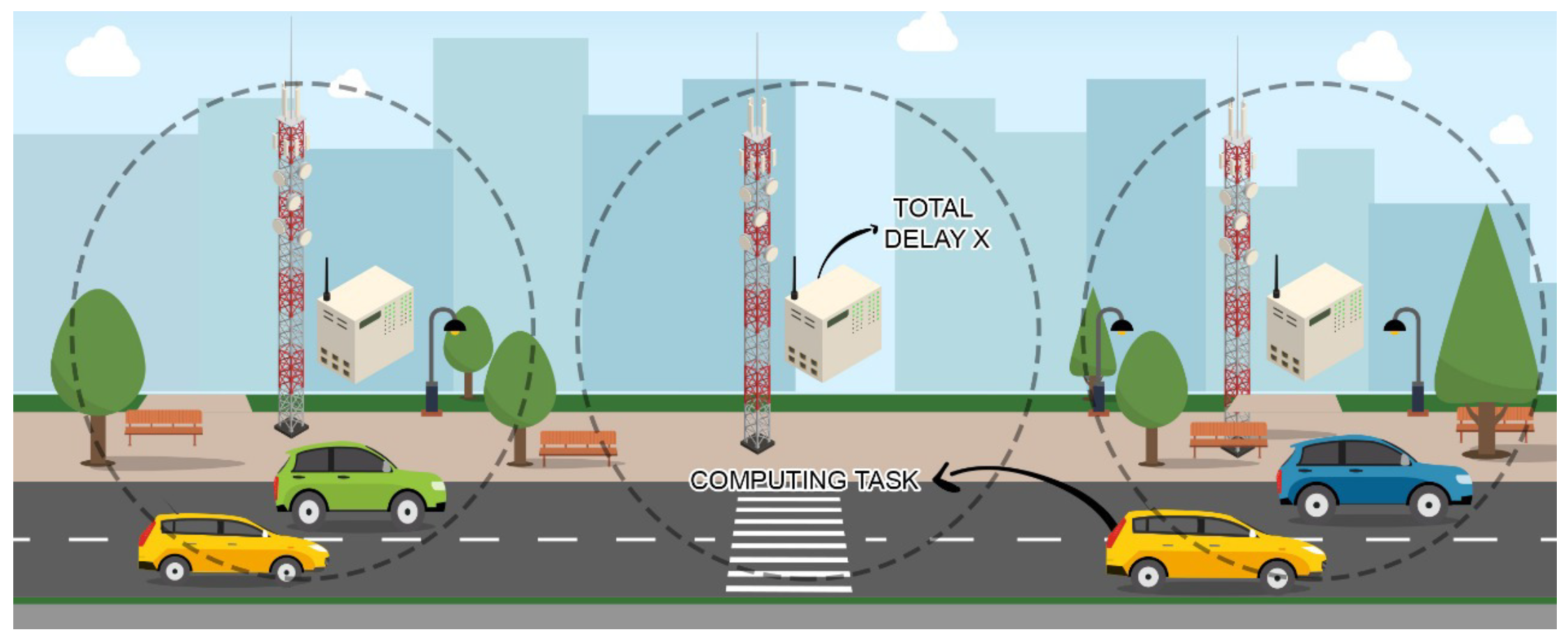
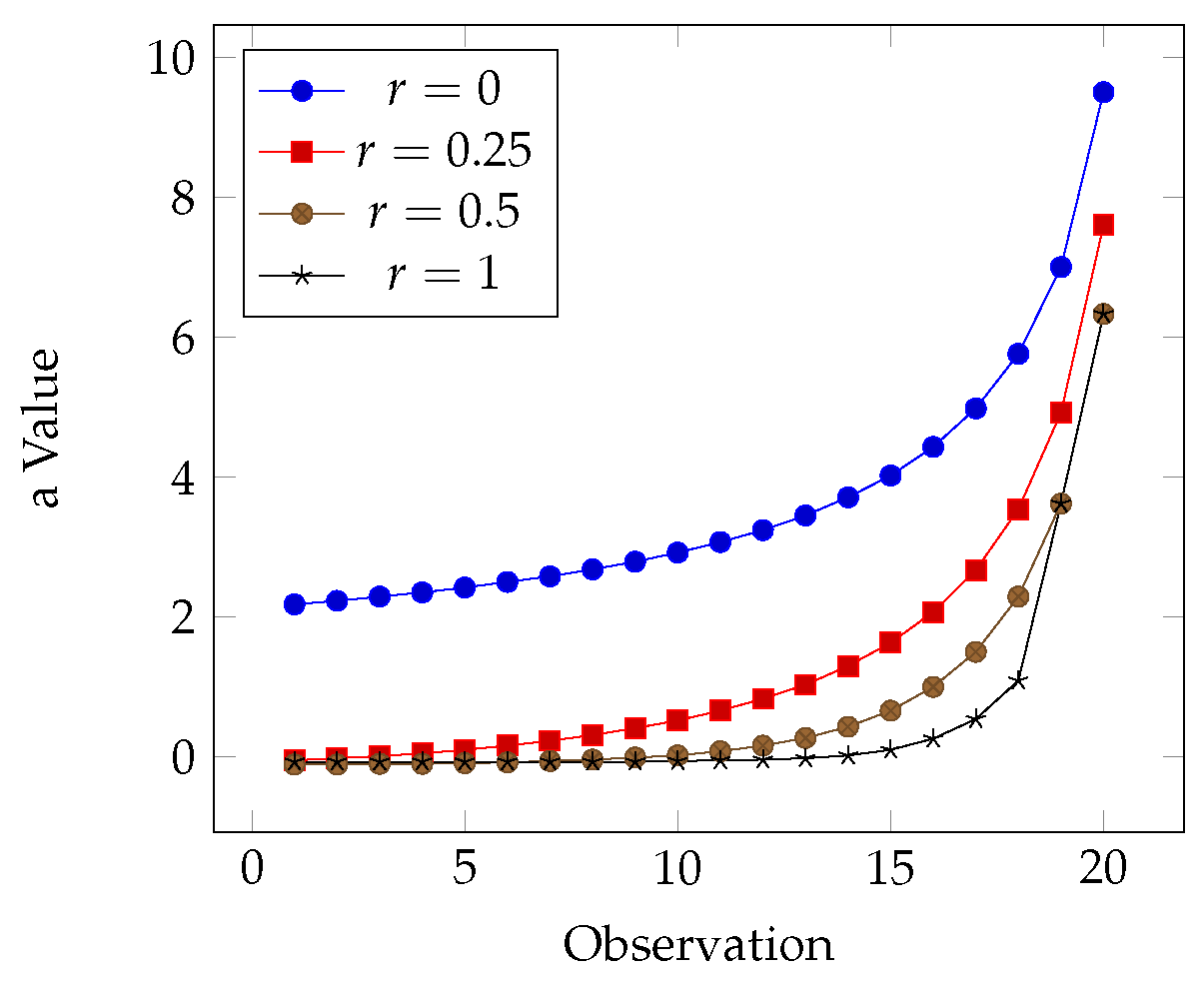
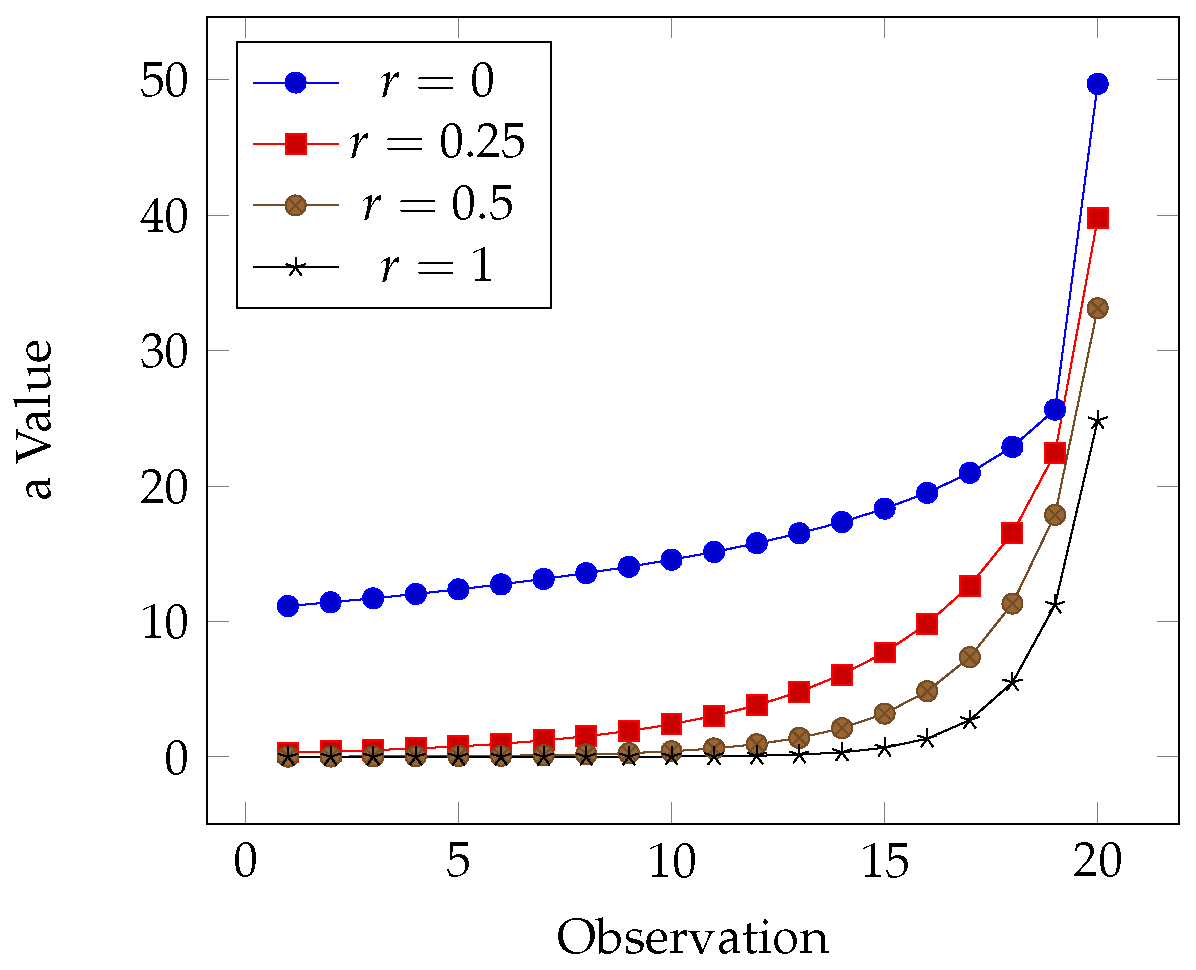
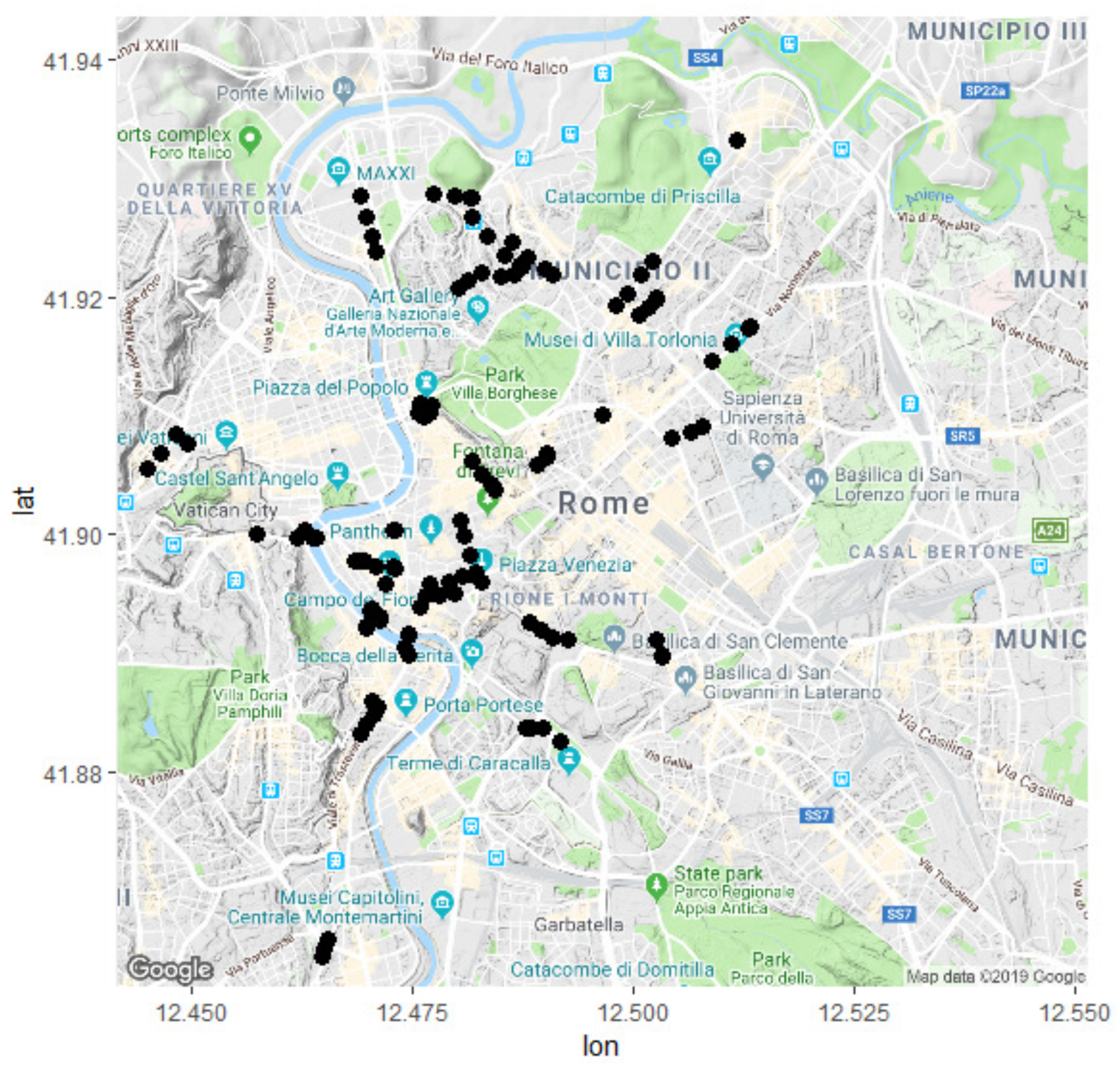
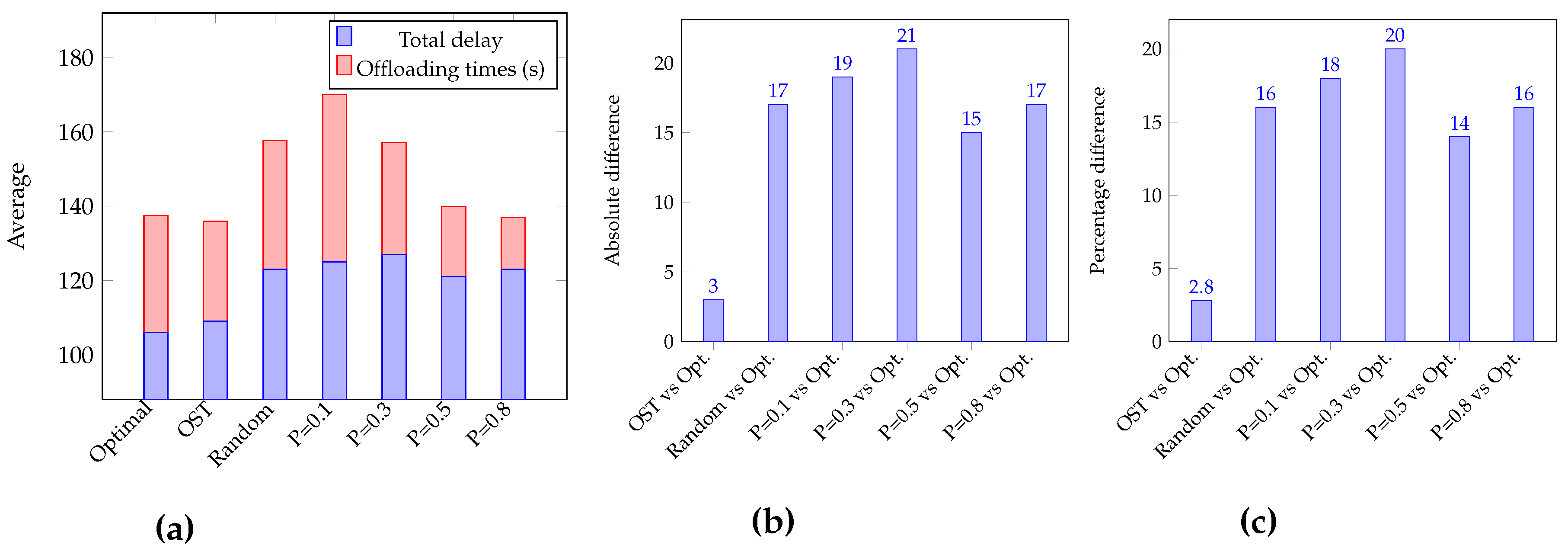
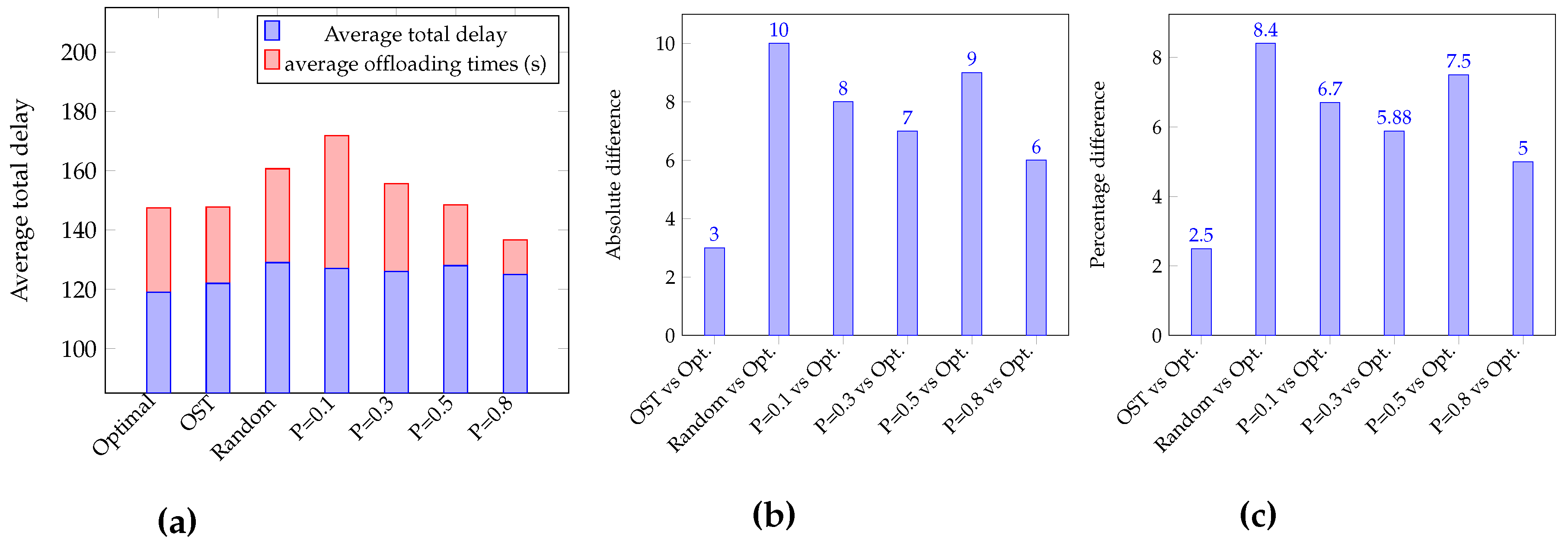
| Cab-ID | Location | Machine Name | Time | CPU and Memory Utilization |
|---|---|---|---|---|
| 156 | (41.88367, 12.48778) | m_1939 | 03:24:20 | (41,92) |
| 156 | (41.88360, 12.48844) | m_1936 | 01:06:50 | (43,92) |
| 156 | (41.88376, 12.48968) | m_1941 | 16:20:00 | (44,92) |
| 156 | (41.88251, 12.49179) | m_1941 | 13:23:50 | (46,49) |
| Cab-ID | Location | Machine Name | Time | CPU and Memory Utilization |
|---|---|---|---|---|
| 156 | (41.88367, 12.48778) | m_1934 | 00:42:40 | (34,89) |
| 156 | (41.88360, 12.48844) | m_1934 | 00:43:00 | (35,89) |
| 156 | (41.88376, 12.48968) | m_1934 | 00:44:00 | (27,88) |
| 156 | (41.88251, 12.49179) | m_1934 | 00:46:40 | (24,87) |
© 2019 by the authors. Licensee MDPI, Basel, Switzerland. This article is an open access article distributed under the terms and conditions of the Creative Commons Attribution (CC BY) license (http://creativecommons.org/licenses/by/4.0/).
Share and Cite
Alghamdi, I.; Anagnostopoulos, C.; P. Pezaros, D. Delay-Tolerant Sequential Decision Making for Task Offloading in Mobile Edge Computing Environments. Information 2019, 10, 312. https://doi.org/10.3390/info10100312
Alghamdi I, Anagnostopoulos C, P. Pezaros D. Delay-Tolerant Sequential Decision Making for Task Offloading in Mobile Edge Computing Environments. Information. 2019; 10(10):312. https://doi.org/10.3390/info10100312
Chicago/Turabian StyleAlghamdi, Ibrahim, Christos Anagnostopoulos, and Dimitrios P. Pezaros. 2019. "Delay-Tolerant Sequential Decision Making for Task Offloading in Mobile Edge Computing Environments" Information 10, no. 10: 312. https://doi.org/10.3390/info10100312
APA StyleAlghamdi, I., Anagnostopoulos, C., & P. Pezaros, D. (2019). Delay-Tolerant Sequential Decision Making for Task Offloading in Mobile Edge Computing Environments. Information, 10(10), 312. https://doi.org/10.3390/info10100312






